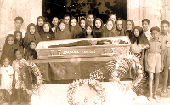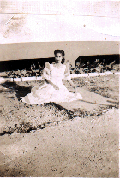|
The customs that had governed marriage practices from the Spanish period remained in place. An important marriage
institution was the dasel, the bridge price, or more accurately the initial fund of conjugal property provided by the groom
and his family. Traditionally, this fund was anticipatory inheritance by the groom which consisted of irrigated riceland,
residential property, a draught animal and a full complement of farm equipment. The negotiation of the amount of the
dasel was the sensitive task of specialist in marriage mediation, the albahiyas, for this male dowry must be commensurate
to the social status of the bride.
Those of middle class modified dasel to a cash fund of to residential property.
For conventional marriages, the albahiyas continued to be used, and their function was considered in despensable.
|
Elaborate wedding feast continued to be important social occasions both in
the poblacion and the barrios, featuring pre-nuptial feast on the eve of the wedding, as well as on the day itself at the
home of the bride, all expenses to be borne by the groom's family.
The wedding feast was followed by the pagatin where the bride was welcomed at the house of the
groom. The family of the groom brought to the home of the bride 12 kinds of food or dishes borne on circular baskets
(bilaos) atop the heads of chosen bearers. Still another pre-nuptial institution was the practice of the bride service,
wherein the groom volunteered to work in the girl's house.
|
Funerary Practices
Mourning customs remained unchanged. The wearing of proper mourning attire, particularly for the immediate family,
was the regueur. This meant wearing black clothing and a black veil for the women for the duration of the mourning period.

Example of a burial practices before.

Clothing and Material Culture
Because of the deprivation suffered during the war, women's dress had simpler lines while the men used short-sleeved
sportswear. The use of coat and tie by the men was reserved for very formal occasions. In the town centers, material
progress among the middle was reflected in the construction of more houses of wood roofed with galvanized iron to replace
the old houses of bamboo and nipa. Material furnishing in the western style were already introduced in the Spanish period.

|



